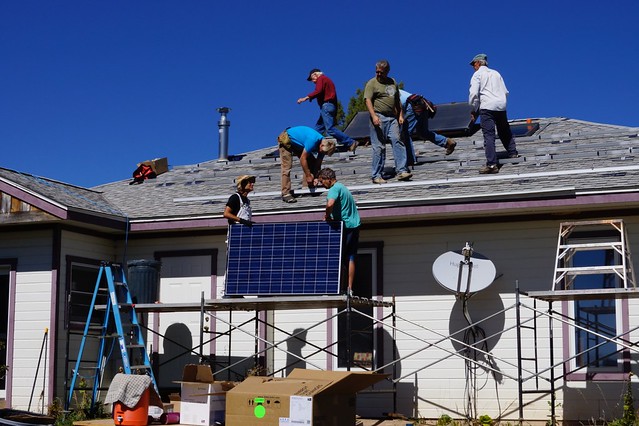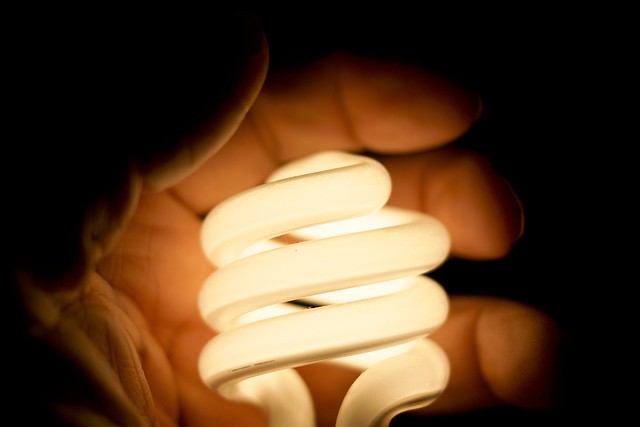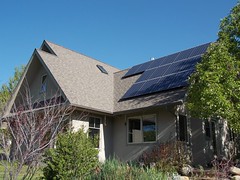On the 25th of October I had the pleasure of participating in a solar barn raising in North Dalton, about 20 minutes North of Durango proper, the exact location being the lovely home of Norton and Debbie Hindley. Despite my enthusiasm for renewable energy, I had never actually seen solar panels being installed on a building before, nor really given any serious thought to actually doing it myself.
I certainly had some butterflies to accompany my excitement about the experience. I didn't want to be the tyro getting in the way of the pros, but luckily the experienced part of the crew, which was all but myself and one other person, were incredibly accommodating toward my complete lack of knowledge. Luckily, it doesn't take too long to catch on to some of the basics of installation.
 My solar installation education began with the 'slap in the face' realization that solar barn raising does not have anything to do with the construction of a barn. Looking back at it I feel rather silly, having worked for a company that dealt in the sale of wind and solar energy supply to homes, but I showed up thinking, “Where’s the stuff for the barn?” I was unfamiliar with the term “solar barn raising”, which led me to assume we were putting together a stand alone barn or shed like structure that the solar array would be placed upon.
My solar installation education began with the 'slap in the face' realization that solar barn raising does not have anything to do with the construction of a barn. Looking back at it I feel rather silly, having worked for a company that dealt in the sale of wind and solar energy supply to homes, but I showed up thinking, “Where’s the stuff for the barn?” I was unfamiliar with the term “solar barn raising”, which led me to assume we were putting together a stand alone barn or shed like structure that the solar array would be placed upon.
Turns out, I wasn't too far off, as a solar barn raising can mean both the construction of a stand alone array, which could be an actual barn if you so desire, or the installation of photo voltaic panels on the southern facing portion of the roof of a home. Really it was one of those instances where my insecurity of not knowing anything about what I was doing or anybody I was working with got in the way of me looking it up on Google.
The day before, solar panel installer Jay Hecker and company had started some of the initial installation steps for the panels by drilling holes into the trusses. We began by installing metal flashing between the layers of shingles, followed by flanges into the flashing, which would later hold the beam, or racking, that panels would be tightened to. It doesn't sound like a lot when put into words, but make no mistake, installing solar panels is time consuming, and if it’s a warm fall day, roofs can become very hot, especially if they are covered with black tar shingles. The day's work was extended well past 4 PM for some of the crew.
Since I’m no expert, I can’t quite say that any single material is the most important in solar panel installation, but it turns out that having the right grade of aluminum nuts for bolting down the panels is extremely critical. Because of their relative lightweight and large surface area and general exposure to the elements, if a gust of wind is at the right speed, it can tear a solar panel off of a roof if it is not held down properly. Because the grade of aluminum nuts we were using was inferior, they kept cracking when we were tightening them down with a torque wrench, which didn't bode well for the possibility of high winds, which are not uncommon in the San Juan Mountains. Barn raising coordinator John Lyle had to drive back into town to purchase nuts that are most commonly used on toilets, which are currently holding up quite nicely.
Because of La Plata Electric Associations (LPEA) guidelines, Norton and Debbie could only have fifteen solar panels installed that day, even though they intended to install quite a few more. However, they were able to successfully petition LPEA and now their home is primarily powered by solar.
The best thing I took away from my day in North Dalton, aside from better knowledge of solar panels and their installation, was the fact that solar barn raising help increases the community visibility and strengthening and building comradery among volunteers, and significantly reducing the costs for the homeowner. Solar panel prices are still decreasing, but by cutting out the costs of labor, the return on investment is larger and the payback time is much shorter. It also serves as an excellent community building exercise, where individuals can get together and have a positive impact on their surroundings.
Other than that, I took home probably one of the gnarliest sunburns I have ever had in my life from the combination of eight hours of sun and hot roof. Join the next solar barn raising effort, but don't forget to wear sunscreen.
About the Author
A Durango local, John 'Jack' Dea is a 4CORE intern who recently graduated from the University of Oregon with a Bachelors in Political Science, specializing in Environmental Policy and Political Economy. After a term at Duquesne University School of Law in Pittsburgh, PA, John decided that his true passion lay in environmental sciences, conservancy, and sustainable residential and business practices. John's professional background includes working in sales for Green Mountain Energy Company, a national wind power supplier, before finally relocating back to Durango. John is currently preparing to apply to Graduate School in pursuit of a Master's in an environmental science related degree.
I certainly had some butterflies to accompany my excitement about the experience. I didn't want to be the tyro getting in the way of the pros, but luckily the experienced part of the crew, which was all but myself and one other person, were incredibly accommodating toward my complete lack of knowledge. Luckily, it doesn't take too long to catch on to some of the basics of installation.
 My solar installation education began with the 'slap in the face' realization that solar barn raising does not have anything to do with the construction of a barn. Looking back at it I feel rather silly, having worked for a company that dealt in the sale of wind and solar energy supply to homes, but I showed up thinking, “Where’s the stuff for the barn?” I was unfamiliar with the term “solar barn raising”, which led me to assume we were putting together a stand alone barn or shed like structure that the solar array would be placed upon.
My solar installation education began with the 'slap in the face' realization that solar barn raising does not have anything to do with the construction of a barn. Looking back at it I feel rather silly, having worked for a company that dealt in the sale of wind and solar energy supply to homes, but I showed up thinking, “Where’s the stuff for the barn?” I was unfamiliar with the term “solar barn raising”, which led me to assume we were putting together a stand alone barn or shed like structure that the solar array would be placed upon.Turns out, I wasn't too far off, as a solar barn raising can mean both the construction of a stand alone array, which could be an actual barn if you so desire, or the installation of photo voltaic panels on the southern facing portion of the roof of a home. Really it was one of those instances where my insecurity of not knowing anything about what I was doing or anybody I was working with got in the way of me looking it up on Google.
The day before, solar panel installer Jay Hecker and company had started some of the initial installation steps for the panels by drilling holes into the trusses. We began by installing metal flashing between the layers of shingles, followed by flanges into the flashing, which would later hold the beam, or racking, that panels would be tightened to. It doesn't sound like a lot when put into words, but make no mistake, installing solar panels is time consuming, and if it’s a warm fall day, roofs can become very hot, especially if they are covered with black tar shingles. The day's work was extended well past 4 PM for some of the crew.
Since I’m no expert, I can’t quite say that any single material is the most important in solar panel installation, but it turns out that having the right grade of aluminum nuts for bolting down the panels is extremely critical. Because of their relative lightweight and large surface area and general exposure to the elements, if a gust of wind is at the right speed, it can tear a solar panel off of a roof if it is not held down properly. Because the grade of aluminum nuts we were using was inferior, they kept cracking when we were tightening them down with a torque wrench, which didn't bode well for the possibility of high winds, which are not uncommon in the San Juan Mountains. Barn raising coordinator John Lyle had to drive back into town to purchase nuts that are most commonly used on toilets, which are currently holding up quite nicely.
Because of La Plata Electric Associations (LPEA) guidelines, Norton and Debbie could only have fifteen solar panels installed that day, even though they intended to install quite a few more. However, they were able to successfully petition LPEA and now their home is primarily powered by solar.
The best thing I took away from my day in North Dalton, aside from better knowledge of solar panels and their installation, was the fact that solar barn raising help increases the community visibility and strengthening and building comradery among volunteers, and significantly reducing the costs for the homeowner. Solar panel prices are still decreasing, but by cutting out the costs of labor, the return on investment is larger and the payback time is much shorter. It also serves as an excellent community building exercise, where individuals can get together and have a positive impact on their surroundings.
Other than that, I took home probably one of the gnarliest sunburns I have ever had in my life from the combination of eight hours of sun and hot roof. Join the next solar barn raising effort, but don't forget to wear sunscreen.
About the Author
A Durango local, John 'Jack' Dea is a 4CORE intern who recently graduated from the University of Oregon with a Bachelors in Political Science, specializing in Environmental Policy and Political Economy. After a term at Duquesne University School of Law in Pittsburgh, PA, John decided that his true passion lay in environmental sciences, conservancy, and sustainable residential and business practices. John's professional background includes working in sales for Green Mountain Energy Company, a national wind power supplier, before finally relocating back to Durango. John is currently preparing to apply to Graduate School in pursuit of a Master's in an environmental science related degree.



.jpg)





































